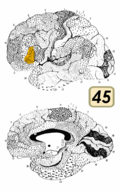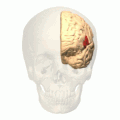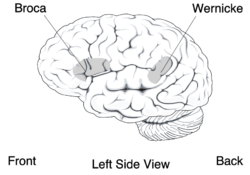Broca's area
Broca's area is a region in the brain of humans and other hominids. It is in the frontal lobe of the dominant hemisphere, usually the left.[1] It works as part of "speech production".
| Brain: Broca's area | ||
|---|---|---|
| Broca's area is made up of Brodmann areas 44 (pars opercularis) and 45 (pars triangularis) | ||
| Broca's area (shown in red) | ||
| Part of | Frontal lobe | |
| Artery | Middle cerebral | |
| Vein | Superior sagittal sinus | |
Language processing has been linked to Broca's area after Pierre Paul Broca. Broca did autopsies on patients who had difficuty speaking when they were alive. He found damage to a particular area of the brain.[2][3] They had lost the ability to speak after injury to the posterior inferior frontal gyrus of the brain.[4]
Since then, the region he identified has become known as Broca's area. The deficit in language production is Broca's aphasia, also called 'expressive aphasia'.[4]
Functional magnetic resonance imaging (fMRI) studies have identified activation patterns in Broca's area associated with various language tasks. However, slow destruction of the Broca's area by brain tumors can leave speech relatively intact. This suggests that, given time, its functions can shift to nearby areas in the brain.[5]
Broca's Area Media
Arcuate fasciculus connects Broca's area and Wernicke's area.
Human brain dissection video (24 sec). Demonstrating the location of Broca's area in inferior frontal gyrus.
Related pages
References
- ↑ Cantalupo, Claudio & Hopkins, William D. 2001 (2001). "Asymmetric Broca's area in great apes". Nature. 414 (6863): 505. Bibcode:2001Natur.414..505C. doi:10.1038/35107134. PMC 2043144. PMID 11734839.
{{cite journal}}: CS1 maint: multiple names: authors list (link) - ↑ Boeree C.G. (2004). "Speech and the brain".
- ↑ Kennison, Shelia (2013). Introduction to language development. Los Angeles: Sage.
- ↑ 4.0 4.1 Dronkers N.F. et al 2007 (2007). "Paul Broca's historic cases: high resolution MR imaging of the brains of Leborgne and Lelong". Brain. 130 (Pt 5): 1432–1441. doi:10.1093/brain/awm042. PMID 17405763.
- ↑ Plaza M. et al 2009 (2009). "Speaking without Broca's area after tumor resection". Neurocase. 15 (4): 294–310. doi:10.1080/13554790902729473. PMID 19274574. S2CID 16683208.









